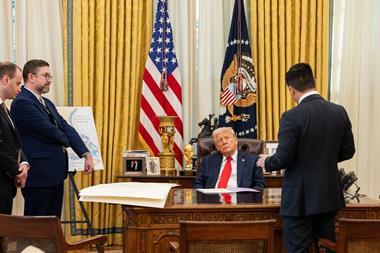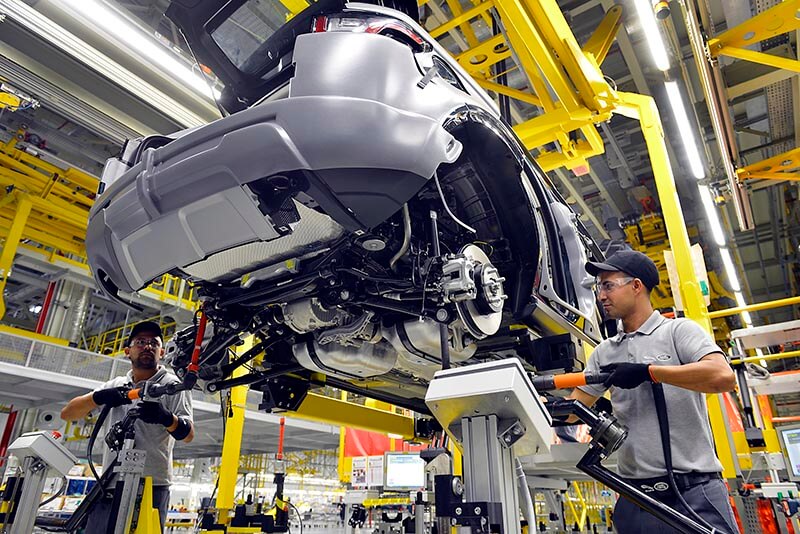 Brazilian vehicle sales have been gathering pace recently, as the country tentatively recovers from its long recession. Light vehicle sales have shown some growth, while bus and truck sales have positively motored ahead. Vehicle sales this year, however, have been tarnished somewhat by stalling exports – especially to Argentina, which is the largest foreign purchaser of Brazilian-made cars.
Brazilian vehicle sales have been gathering pace recently, as the country tentatively recovers from its long recession. Light vehicle sales have shown some growth, while bus and truck sales have positively motored ahead. Vehicle sales this year, however, have been tarnished somewhat by stalling exports – especially to Argentina, which is the largest foreign purchaser of Brazilian-made cars.
Brazil’s National Vehicle Manufacturers’ Association, Anfavea, reported total new vehicle registrations of 2.1m units in the first ten months of the year, up 15.3% on the same period in 2017, with light vehicle numbers climbing 14%, buses growing by 29% on strong city bus purchases, and trucks soaring 50% on fleet renewals and booming agribusiness.
Manufacturers in the country such as General Motors (with its high-selling Onix) and Nissan, and logistics service providers such as Tegma, Penske and DHL appear optimistic about the next 12 months and the opportunities ahead, and Anfavea has predicted continued double-digit growth in sales in 2019.
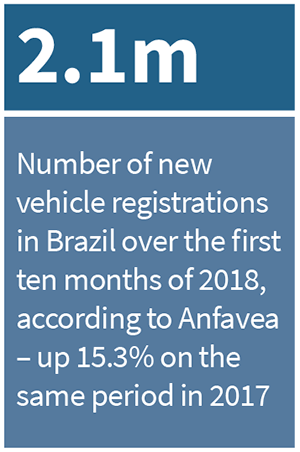 In the wider economy, positive signals can be seen. Over the first ten months of 2018, Brazil’s GDP rose by around 1.3%, after one of its longest recessions in history, and according to a Central Bank survey of economists, this should edge up to around 2.5% by the end of 2019. Meanwhile, inflation largely came under control at around 4% and the Central Bank’s benchmark Selic interest rate fell to a low of 6.5%. The Brazilian real also strengthened slightly to around 3.70 reais to one US dollar, after the presidential election run-off on October 28.
In the wider economy, positive signals can be seen. Over the first ten months of 2018, Brazil’s GDP rose by around 1.3%, after one of its longest recessions in history, and according to a Central Bank survey of economists, this should edge up to around 2.5% by the end of 2019. Meanwhile, inflation largely came under control at around 4% and the Central Bank’s benchmark Selic interest rate fell to a low of 6.5%. The Brazilian real also strengthened slightly to around 3.70 reais to one US dollar, after the presidential election run-off on October 28.
Although retail growth remains tepid, non-performing loans have been diminishing and credit is becoming more easily available, too. Unemployment is still at almost 12% – or more than 12m people – but is also slowly starting to improve.
After controversial Jair Bolsonaro’s election victory in October, the financial market rose sharply. The local business community now hopes he will tackle corruption and help boost the economy. President-elect Bolsonaro has already appointed Chicago-trained economist Paulo Guedes as finance minister, and he advocates market-friendly policies, large-scale privatisation, and a reduction in the fiscal deficit, messages that will appeal to most investors and businesses.
Maurício Almeida, senior director of operations at DHL Supply Chain for Brazil, says Anfavea’s registration data showed 25.6% growth year-on-year in October, the best performance in that month since 2014. “With clarity surrounding the election and relative macroeconomic stability, we hope for more intense growth in 2019, which should also generate a positive reaction in the logistics sphere,” he comments.
Brazilian logistics service provider Tegma Gestão Logística is also positive about the future. Gennaro Oddone, Tegma’s CEO, says the new government will prioritise an agenda that, in the medium term, should balance the public accounts.
Oddone hopes in particular for a continuation of current low interest rates and an expansion of credit for consumers, as well as a fall in unemployment. “If these measures are successful, we should observe growth in the automobile sector for next year that beats this year, and this will be reflected in our operation. They can create the conditions for economic growth acceleration in 2019,” he says.
 "If these [economic] measures are successful, we should observe growth in the automobile sector for next year that beats this year, and this will be reflected in our operation." - Gennaro Oddone, Tegma Gestão Logística
"If these [economic] measures are successful, we should observe growth in the automobile sector for next year that beats this year, and this will be reflected in our operation." - Gennaro Oddone, Tegma Gestão Logística
Exports tumbleHowever, Brazil, which was the world’s fifth largest vehicle manufacturer before the recession, has seen stronger domestic vehicle sales counteracted by a weakening in exports. These tumbled almost 11% in the first ten months of this year, compared to the same period a year ago, to 563,000 units.
This was caused by various external factors. Neighbouring Argentina’s soaring debt, double-digit inflation and sharp currency devaluation, for example, forced President Mauricio Macri’s government to take a $56 billion IMF loan, as the country fell out of favour with investors and the population hunkered down for worsening economic conditions. Mexico, another important destination for Brazil’s car exporters, also faced a presidential election in mid-2018, causing many consumers and investors to sit on the sidelines and wait for greater political and economic certainty.
Jaguar Land Rover’s MD for Latin America, Frédéric Drouin, agrees that this year, the Brazilian automotive market has been in recovery. But the signals show economic improvement, with consumers regaining confidence and car sales increasing slightly, he says.
Jaguar Land Rover (JLR) is confident about expanding in Brazil and Latin America, he continues. The company has sold 6,560 vehicles so far this year in Brazil, registering 18% growth compared to last year, and the luxury segment there has grown 7%. The numbers should remain positive until the end of the year, Drouin suggests.

JLR currently operates via Rio de Janeiro state, where it has a single compound for manufacturing as well as to consolidate imported and locally-made vehicles for distribution. The carmaker uses local finished vehicle logistics specialist Sada to handle its logistics activities.
Drouin says imports into Brazil are critical for JLR because the cars are premium models and the company does not have high local stocks from which to supply dealers. The OEM must be efficient in its import operation and has therefore invested in compound facilities to secure synergies in its distribution activities.
Drouin remains optimistic, pointing out that JLR offers a complete line-up of vehicles via 40 dealers across the country. The luxury segment represents just 2.4% of the Brazilian automotive market, so “there is still space for growth,” he comments.
Although a third of JLR’s sales in the region come from Brazil, another third comes from Mexico, while the rest is spread across more than 10 countries in Latin America with Bogota being the hub for Central American imports. Colombia was JLR’s fastest growing country in the region in 2017, up around 40% year-on-year, thanks to a growing economy and a peace dividend after years of terrorist attacks.
Continuing challengesPaulo Sarti, MD of Penske Logistics in South America, says 2018 continued to be a challenging year in terms of the overall economy, but the auto sector overall performed better than in the year before.
According to Sarti, the main challenges were on the road transport side, due to the truckers' strike in May which brought major cities and key highways to a standstill and led to shortages of fuel, halting deliveries and temporarily shutting down many businesses.
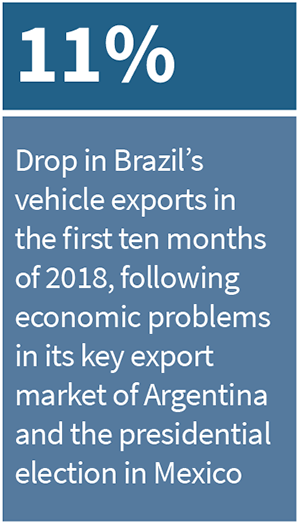 Even before the strike, however, a lack of haulage capacity had also been an issue, says Sarti. The market was not ready, as volumes began to recover, and like others, Penske felt the consequences in a lack of available trucks and cost increases nationwide, he says.
Even before the strike, however, a lack of haulage capacity had also been an issue, says Sarti. The market was not ready, as volumes began to recover, and like others, Penske felt the consequences in a lack of available trucks and cost increases nationwide, he says.
Japanese carmaker Nissan has also experienced capacity issues and sees further potential obstacles ahead. Sandro Santos, Nissan’s outbound logistics manager, says the OEM expects more intense competition in the transport sector for available trucks and space on vessels, as the economy stabilises and the automotive sector recovers at a faster pace.
Investing for the futurePenske’s Sarti says the LSP has invested heavily in the past two years, most notably in a new IT platform. This has included new routing, optimisation and visibility tools, which provide better services for customers. “As we made that investment during a downturn, we are ready for the growth that will come," he states.
Penske, which handles aftermarket business for a number of major automakers in Brazil, is also investing to improve its lead logistics provider (LLP) solutions as another way to generate savings for its customers. “We are providing LLP services for the automotive industry where we are in charge of the routing, optimisation and management of inbound flows to production plants,” Sarti says.
DHL has also been strengthening its transport capabilities and LLP services. Working with both vehicle-makers and suppliers, Almeida says it has expanded its capabilities in terms of its fleet, new cross-docking operations, two surveillance towers, and new technologies to support these areas.
DHL has also reinforced its efforts in terms of supply chain management. In the case of the vehicle market, the company has seen clear demand for aftermarket services, as the auto repair market is still busy. DHL has also continued to work in the area of in-plant logistics, focusing mainly on new plants and operations.
In parallel, Almeida says, DHL has also been working on innovative solutions for better visibility in the supply chain. These include the use of semi-autonomous vehicles at some sites as well as drones for surveillance and stock-checking.
[mpu_ad]Almeida justifies such investments by citing a recent global survey DHL undertook, which showed that 83% of companies were willing to pay more for better, more value-added logistics services, as long as they provided a measurable return on investment. The study also found that increasingly, companies see land transport as more than just a simple tactical commodity, with 71% of respondents suggesting it was a strategic part of their business.
Seeking better visibilityTo help overcome the haulage capacity problem, Santos says Nissan’s supply chain department seeks to act pre-emptively to ensure better visibility, while controlling all of the process inefficiencies that may cause losses. Nissan does this by ensuring logistics specialists work closely together with sales and manufacturing teams to follow strategic decisions related to production volumes and sales. By doing so, Nissan is better able to plan its transport activities with suppliers, he says.
Santos says Nissan is investing in new software to manage the entire distribution process, allowing it to view and control operations, while ensuring deliveries are made in an integrated manner. This gives Nissan an overview of all the processes involved and helps it to achieve greater productivity and agility in the supply chain, reducing manual controls and automating them, he says. The people involved in these operations now have more time to devote to planning and implementing the company’s strategic vision, he adds.
Nissan continues to search for innovative advances in road transport, too. “We participate in meetings in the segment, including those abroad, to learn about the main changes in terms of innovation, something that is fundamental for our fast-moving logistics chain. This is important as Nissan’s challenge is to deliver vehicles to its dealers in the best way and at the lowest cost, while reducing the time needed,” Santos explains.
 "We participate in meetings… to learn about the main changes in terms of innovation [in road transport], something that is fundamental for our fast-moving logistics chain. This is important as Nissan’s challenge is to deliver vehicles to its dealers in the best way and at the lowest cost, while reducing the time needed." - Sandro Santos, Nissan
"We participate in meetings… to learn about the main changes in terms of innovation [in road transport], something that is fundamental for our fast-moving logistics chain. This is important as Nissan’s challenge is to deliver vehicles to its dealers in the best way and at the lowest cost, while reducing the time needed." - Sandro Santos, Nissan
Grappling with changeTegma’s Oddone says the automotive industry faced a drop of around 50% in 2015-2016, leaving the 3PL with a similar fall in vehicle volumes. That led to a readjustment in its cost structure, he says. “Today we are prepared for the continuation of the sector’s growth,” he comments.
Tegma, which posted a net income of 31m reais ($8.3m) in the third quarter, currently works for most of the major carmakers in Brazil and many importers, and has a market share of 27%. In addition to vehicle transport, it offers 1.8m sq.m of paved parking, as well as vehicle accessorisation and warehousing services, and works with around 2,000 direct collaborators.
Oddone says importing and exporting vehicles can still involve multiple challenges. He points out that, at the borders, the Comex foreign trade documentation system is complex, the IT used is often only medium-quality, and vehicle inspections are subject to constant labour-related interruptions. At ports, meanwhile, aspects such as driver support, ramps and safety structures could be improved, he says.
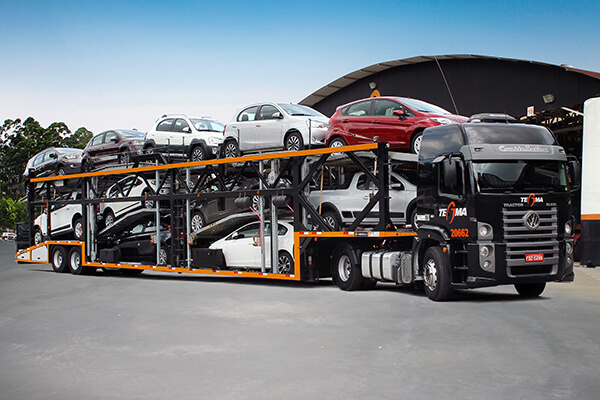 Tegma experienced a sharp fall in volumes as car sales dropped in 2015-2016 but says it is now well positioned for further growth
Tegma experienced a sharp fall in volumes as car sales dropped in 2015-2016 but says it is now well positioned for further growthNonetheless, the 1,400-employee company usually schedules deliveries to ports to avoid major delays, and customs checks do not affect it, he admits, as Tegma only handles cars in the port area where clearance will take place.
Other hurdles Many of Brazil’s other, long-running challenges still continue to hamper carmakers and LSPs, from pothole-ridden highways to perplexing red tape and complex rules. JLR’s Drouin says the quality of roads must be improved especially in the north of the country, to reduce the level of damage caused to premium cars.
DHL’s Almeida, meanwhile, says some of the measures currently under discussion, including reducing bureaucracy, simplifying the tax system, and other improvements in the business environment, will be very welcome. Intensifying planning and investment in infrastructure are other key factors that would help boost the competitiveness of the Brazilian market, he adds.
Nissan’s Santos says Brazil’s road network is still used for delivery of 75% of the company’s output, with rail accounting for just 5% and the rest being delivered by sea or air. “It is of utmost importance to invest in these modes of transport to have competitive cost and safety options, which are two points that directly impact on the final price of the product,” he says.
Despite such issues, the improving economic climate in Brazil has left many carmakers and LSPs optimistic about the future. Sarti summarises the mood well, stating that he sees positive opportunities for the country in 2019 and beyond. There is strong demand for transport management, distribution centre management and lead logistics services, and Brazil’s automotive industry will continue on its growth trajectory, he suggests.
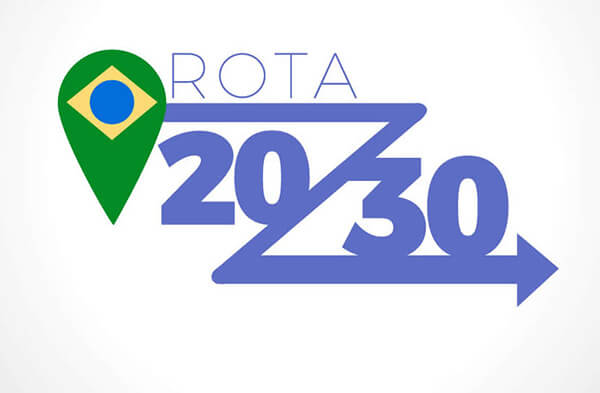 Brazil’s automotive industry should soon receive a further boost from the introduction of a long-awaited tax incentive package known as Rota (Route) 2030, which was approved by the lower house of Congress at the start of November but still needs the Senate’s green light to go ahead.
Brazil’s automotive industry should soon receive a further boost from the introduction of a long-awaited tax incentive package known as Rota (Route) 2030, which was approved by the lower house of Congress at the start of November but still needs the Senate’s green light to go ahead.
BMW has already announced a 150m reais investment to assemble new models with an eye on the programme, while FCA has been planning 14 billion reais of investment through to the end of 2023, subject to the Rota 2030 programme being approved.
The package provides incentives for local manufacturers to improve vehicles’ fuel efficiency and safety. The 15-year incentive programme will also provide tax credits for the next five years, worth around 2.1 billion reais in 2019.
Penske’s Sarti suggests Rota 2030 is very important to the automotive sector in the country. Once it is implemented, he says, carmakers will be able to operate in a more stable environment, receiving benefits and incentives that promote investment in R&D. Brazil’s car industry must be competitive worldwide and the programme provides some useful tools to improve its capabilities, he suggests.
Given the green light from Congress, says Tegma’s Oddone, the Rota 2030 package is likely to be approved and should provide a useful boost to exports. JLR’s Drouin also welcomes the new scheme but he says it is still too early to say just what the impact will be on its business.
DHL’s Almeida says Rota 2030 is a structured plan with a medium and long-term vision for the sector that provides clear investment rules, meanwhile. “Stimulating efficiency and adopting new technologies will bring benefits to consumers and to the supply chain as a whole,” he comments.
Topics
- Air Freight
- Anfavea
- Argentina
- BMW
- BMW
- Brazil
- DHL
- DHL Supply Chain
- Digitalisation
- FCA
- features
- Finished Vehicle Logistics
- General Motors
- GM
- Inbound Logistics
- Jaguar Land Rover
- JLR
- JLR
- Mexico
- Nissan
- Nissan
- North America
- Penske
- Penske Logistics
- Policy and regulation
- Rail
- Road
- ROW
- Shipping
- South America
- South America
- Stellantis
- Tegma
- Tegma Gestão Logística




























